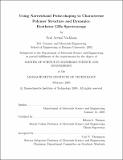| dc.contributor.advisor | Edwin L. Thomas. | en_US |
| dc.contributor.author | Vachhani, Neal Arvind, 1981- | en_US |
| dc.contributor.other | Massachusetts Institute of Technology. Dept. of Materials Science and Engineering. | en_US |
| dc.date.accessioned | 2005-09-26T15:56:44Z | |
| dc.date.available | 2005-09-26T15:56:44Z | |
| dc.date.copyright | 2005 | en_US |
| dc.date.issued | 2005 | en_US |
| dc.identifier.uri | http://hdl.handle.net/1721.1/27876 | |
| dc.description | Thesis (S.M.)--Massachusetts Institute of Technology, Dept. of Materials Science and Engineering, 2005. | en_US |
| dc.description | This electronic version was submitted by the student author. The certified thesis is available in the Institute Archives and Special Collections. | en_US |
| dc.description | Includes bibliographical references (leaves 117-122). | en_US |
| dc.description.abstract | (cont.) The validation of this technique for probing amorphous polymer structure and dynamics lays the ground for further study of heterogeneous materials, such as nanocomposites and block copolymers. | en_US |
| dc.description.abstract | A narrowband pulse-shaper called the Deathstar has been used along with a picosecond acoustic technique to study amorphous polymers. The temperature dependence of the longitudinal acoustic velocity and the frequency dependence of the acoustic attenuation have been measured. The frequency range of longitudinal phonons studied is not directly accessible by other spectroscopies. Probing material response in this intermediate regime is valuable because it helps characterize secondary transitions and energy dissipation mechanisms in polymers. Broadband experiments have been done to study the temperature dependence of the acoustic velocity for polystyrene and poly(methyl methacrylate) from 10 K to 300 K. The results are in line with literature values and the predictions of a model based on acoustic impedance mismatch theory. Narrowband studies with the technique used were previously limited to amorphous silica. They are extended for the first time to amorphous polymers. The Deathstar GHz spectroscopy is used to determine the absolute acoustic attenuation coefficient as a function of frequency for PMMA. The values obtained are similar to those found in literature. However, the method used to measured attenuation here is more reliable. The frequency at which attenuation has been measured ranges from 55 GHz to 160 GHz. To explore additional dynamics, attenuation is also measured at temperatures above and below the polymer glass transition. The details of the experimental technique are discussed, and the results are presented. | en_US |
| dc.description.statementofresponsibility | by Neal Arvind Vachhani. | en_US |
| dc.format.extent | 122 leaves | en_US |
| dc.format.extent | 2950805 bytes | |
| dc.format.extent | 2946460 bytes | |
| dc.format.mimetype | application/pdf | |
| dc.format.mimetype | application/pdf | |
| dc.language.iso | en_US | |
| dc.publisher | Massachusetts Institute of Technology | en_US |
| dc.rights | M.I.T. theses are protected by copyright. They may be viewed from this source for any purpose, but reproduction or distribution in any format is prohibited without written permission. See provided URL for inquiries about permission. | en_US |
| dc.rights.uri | http://dspace.mit.edu/handle/1721.1/7582 | |
| dc.subject | Materials Science and Engineering. | en_US |
| dc.title | Using narrowband pulse-shaping to characterize polymer structure and dynamics : Deathstar GHz spectroscopy | en_US |
| dc.type | Thesis | en_US |
| dc.description.degree | S.M. | en_US |
| dc.contributor.department | Massachusetts Institute of Technology. Department of Materials Science and Engineering | |
| dc.identifier.oclc | 60842353 | en_US |
